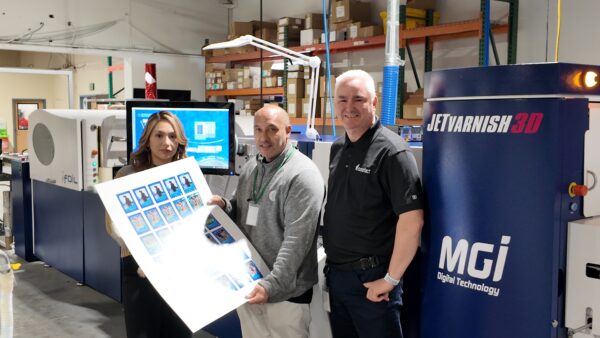Making Inks That Stick
You probably have a photo printer in your home or office that does a fine job of printing sharp, clear, durable photographic images on glossy papers. So, you might be thinking an amped up version of this technology must be on the verge of being rolled out on the big high-speed presses that run at hundreds of meters a minute and are about to transform the printing industry. If that’s what you’re thinking, you’d be wrong.
High Fusion
But, what about those “high fusion inks” you keep hearing about? Those supposedly stick to all kinds of papers and will make inkjet printing the go-to option for digital printing, maybe even pushing out offset. Well maybe, but not yet.
The term “high fusion” was created by Xerox and is still used by that company to describe inks that enable its Trivor 2400 continuous-feed inkjet press to print on coated papers. The term has become somewhat genericized with its meaning now dependent on whom you talk with. Because the term was coined by Xerox, other vendors and most industry analysts don’t use it. However, most equipment vendors offer inks that work well on a broad range of coated and uncoated papers without compromising press speed. Yet, the ideal solution is still akin to finding the Holy Grail. Progress is being made, but the ideal solution is not going to roll out next Tuesday. And more broadly, adhesion is just one of several processes involving a mix of chemistry and physics that continues to stymie the materials scientists employed by press manufacturers.
Water, Water, Everywhere
It all begins with water.
With the exception of Konica Minolta’s KM-1 UV inkjet press, all the high-speed inkjet devices available today use aqueous inks. These comprise up to 95% water with the reminder being additives and pigment or dye colorants. The problem with water is that it is hard to dry when sprayed on an absorbent material such as paper. Heat lamps, hot air, heated drums and rollers, and drying tunnels are all employed in various combinations but still only address the problem of removing moisture from the sheet. Beyond that are the issues of maintaining dot shape, which affects image quality and getting those droplets to adhere to the paper.
“All these issues are interdependent,” explained Mark Hanley, president of IT Strategies, an inkjet market research firm and consultancy based in Hanover, Massachusetts. “For example, if you alter the chemistry of an ink to make it dry quickly, you usually affect other characteristics of the ink.”
For instance, the ink on the page must not dry too soon, because if it does, it may also be drying on the print heads, which can lead to ink nozzle clogs. However, the engineers and scientists working on these machines are trying to balance often incompatible goals, added Hanley.
“Because of these concerns, printers buying any given press must absolutely do their own testing of different papers, inks, and print speeds so they know what will work in their operation,” said Hanley.
For example, the standard inks on some presses may work well with coated papers if the press is slowed down to provide a longer drying time. In a print shop, though, this approach must be thoroughly tested and any perceived productivity gains should be balanced against the costs associated with running the same job on a high-end toner press or other device.
“A printer who is running his inkjet press slower to allow for proper drying, and who does this on every shift, has to ask himself, “˜Am I still going to get sufficient volume off that device to attain the desired ROI?'” said Ed Wong, director of product marketing for Inkjet Solutions at Ricoh.
Following the Money
Hanley’s technical comments are absolutely valid, yet they are only one part of a larger story.
“A key challenge to broader inkjet adoption is the limited substrate range on inkjet presses,” added Wong. “The opportunity is there and customers are looking for ways to print an increasing range of jobs on their inkjet presses.”
Some of this is a technical concern, specifically making a paper’s surface chemistry amenable to inkjet inks. This is especially important because offset papers are generally not compatible with inkjet inks unless they are pre-treated. Pre-treating is a common strategy at the moment, but because only a small proportion of any paper-maker’s product line is pretreated, there are still an immense range of papers that cannot readily be used on an inkjet system.
Like many things in life this comes down to money””which drives the question: Can a paper company justify the investment needed to produce several train loads of inkjet paper for what is still an emerging market?
This is not an idle query. While inkjet printing today accounts for only a tiny fraction of all printing, the opportunity, Wong observed, is huge. Right now, there are only a few hundred high-speed inkjet presses installed worldwide, and most primarily run uncoated papers (mostly books and transactional printing), so the market demand for other papers is not yet high enough to get the attention and commitment of paper companies. Offset printing is still the main player by a huge margin.
As inkjet volumes increase, more paper companies will roll out a broader array of options, but this isn’t happening as fast as many would like. To some extent, this is a chicken and egg problem: There isn’t enough volume to justify making more paper, but the supply of papers can’t rise until there is more demand for inkjet printing on a wide range of stocks. I talked recently with several printers who use Mitsubishi Sword paper, a coated stock that works well with inkjet, but they only did so when necessary due to the paper’s significantly higher cost. All see the potential for inkjet expansion and are frustrated they cannot move forward as quickly as they would like. So, they look to other options.
Priming the Paper
Trying to mitigate some of this, and ensure inks stay attached to papers, most equipment vendors limit their recommended substrate choices for inkjet printing to a selection of qualified papers, specifying those that are pre-treated during manufacturing to work with inkjet inks.
Upping the ante further are priming fluids that aid ink adhesion and improve image quality. HP was first with this, offering a “bonding agent” for its T-Series inkjet presses that is applied only where ink will be placed when running untreated papers. Others followed.
Canon uses its branded ColorGrip priming treatment on its ProStream 1000 continuous feed and VarioPrint i200 and i300 cut-sheet inkjet presses to improve ink adhesion and image quality on coated and uncoated offset stocks that are not pretreated for inkjet presses. Neither the ProStream nor VarioPrint presses require the ColorGrip primer, but the difference the fluid makes in quality and color fidelity is obvious at a glance. Michael Poulin, director of product marketing at Canon Solutions America, says the ProStream machines use an aqueous polymer pigmented ink that allows printing on a wide variety of papers enabling ColorGrip to provide a color gamut that can exceed that of offset presses.
These solutions all work well, and although using priming fluids slightly increases cost per print, the wider range of substrates and the difference in print quality tends to overcome most resistance to the incremental uptick in cost. Still, printers being printers, tend to color outside the lines and see what they can get away with, trying different papers and print speeds to see how far they can push the envelope. Many come up with options that work for their operations.
Evolving Inks
Other companies evolve their inks. In June, Ricoh announced a new ink that is half water and half a solvent-water mix that claimed to provide light and water fastness similar to offset printing, at least for indoor applications. Ricoh says the new ink has a higher optical density, dries faster, has less tendency to curl or cockle the paper because there is less water to remove, and has fewer problems with inter-color bleeding. Improved adhesion may also be in the mix. Preliminary testing shows priming is not needed on offset coated papers and optimal inkjet print speeds can be maintained on a wider array of papers. Ricoh also says the inks will support more coated media. So far, the new ink is available for the company’s new VC Pro 70000 inkjet system, with no word on whether it will trickle down to other devices. Given that the heads are different, downstream migration is presently unlikely, and the new press and inks are aimed squarely at offset press replacement. Stay tuned for more developments.
Document Dependent
Right now, most high-speed inkjet printing involves books, transactional documents, and some direct mail. These applications typically don’t require a wide range of substrates or even extensive ink coverage, but college textbooks with full color images are already in the mix with respect to print volumes, especially on some of HP’s T-Series presses. And watch for more and more direct mail and publications such as manuals and cookbooks to be produced on inkjet systems over the next two or three years. This coming surge in demand is why vendors are developing inks that work on a wider range of substrates.
For now, with the technical challenges and still-modest demand, progress is one of small steps, says IT Strategies’ Hanley. Yet, each success moves inkjet forward. Several printers have told me they have bought their last offset press, and some have made space in their climate-controlled digital press area for a second inkjet device. Overall inkjet penetration may still be small, but technical advances continue to bring forth surprises. Inkjet growth and market share is a long game; however, given the way evolving technology has a habit of accelerating change, more advances are likely in the wings.
Access Related Content
Visit the www.thecannatareport.com. To become a subscriber, visit www.thecannatareport.com/register or contact cjcannata@cannatareport.com directly. Bulk subscription rates are also available.




